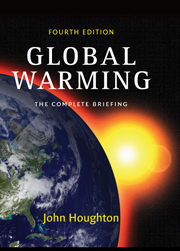Book contents
- Frontmatter
- Contents
- Preface
- 1 Global warming and climate change
- 2 The greenhouse effect
- 3 The greenhouse gases
- 4 Climates of the past
- 5 Modelling the climate
- 6 Climate change in the twenty-first century and beyond
- 7 The impacts of climate change
- 8 Why should we be concerned?
- 9 Weighing the uncertainty
- 10 A strategy for action to slow and stabilise climate change
- 11 Energy and transport for the future
- 12 The global village
- Appendix 1
- Appendix 2 Acknowledgements for figures, photos and tables
- Glossary
- Index
7 - The impacts of climate change
- Frontmatter
- Contents
- Preface
- 1 Global warming and climate change
- 2 The greenhouse effect
- 3 The greenhouse gases
- 4 Climates of the past
- 5 Modelling the climate
- 6 Climate change in the twenty-first century and beyond
- 7 The impacts of climate change
- 8 Why should we be concerned?
- 9 Weighing the uncertainty
- 10 A strategy for action to slow and stabilise climate change
- 11 Energy and transport for the future
- 12 The global village
- Appendix 1
- Appendix 2 Acknowledgements for figures, photos and tables
- Glossary
- Index
Summary
THE LAST two chapters have detailed the climate change in terms of temperature and rainfall that we can expect during the twenty-first century because of human activities. To be useful to human communities, these details need to be turned into descriptions of the impact of climate change on human resources and activities. The questions to which we want answers are: how much will sea level rise and what effect will that have?; how much will water resources be affected?; what will be the impact on agriculture and food supply?; will natural ecosystems suffer damage?; how will human health be affected? and can the cost of the likely damage be estimated? This chapter considers these questions.
A complex network of changes
In outlining the character of the likely climate change in different regions of the world, the last chapter showed that it is likely to vary a great deal from place to place. For instance, in some regions precipitation will increase, in other regions it will decrease. Not only is there a large amount of variability in the character of the likely change, there is also variability in the sensitivity (for definition see box below) of different systems to climate change. Different ecosystems, for instance, will respond very differently to changes in temperature or precipitation.
There will be a few impacts of the likely climate change that will be positive so far as humans are concerned.
- Type
- Chapter
- Information
- Global WarmingThe Complete Briefing, pp. 172 - 238Publisher: Cambridge University PressPrint publication year: 2009



